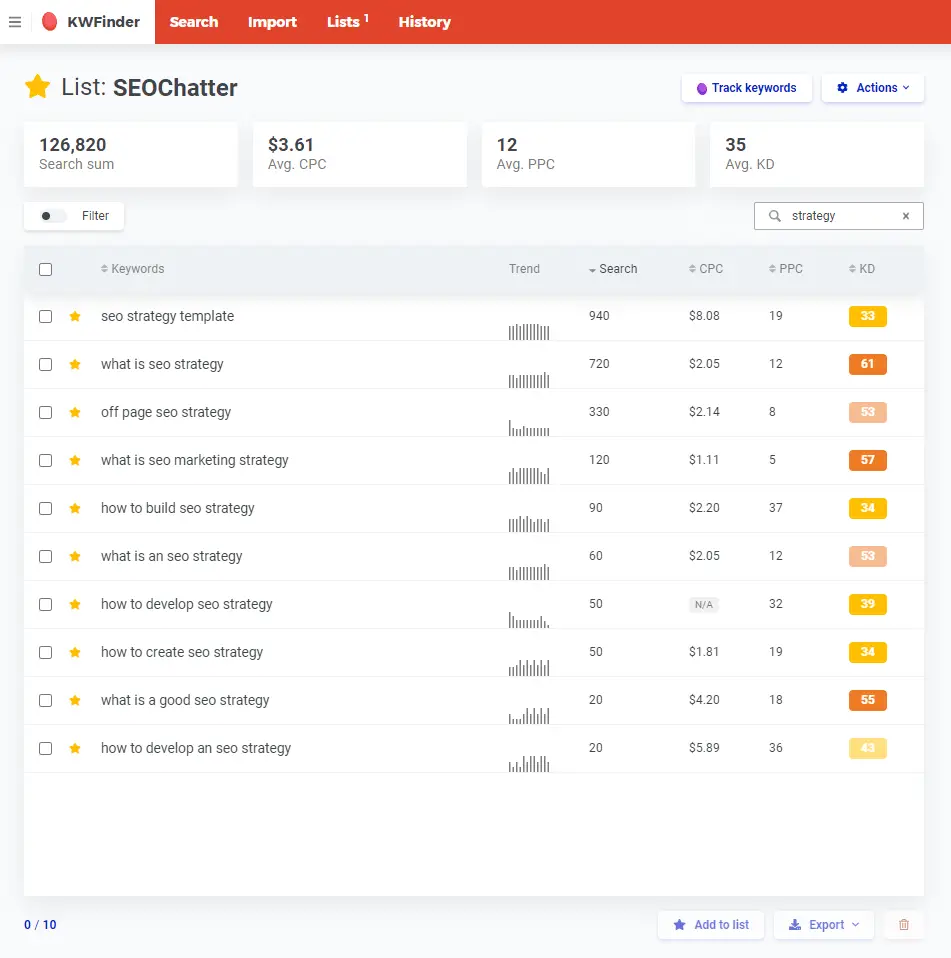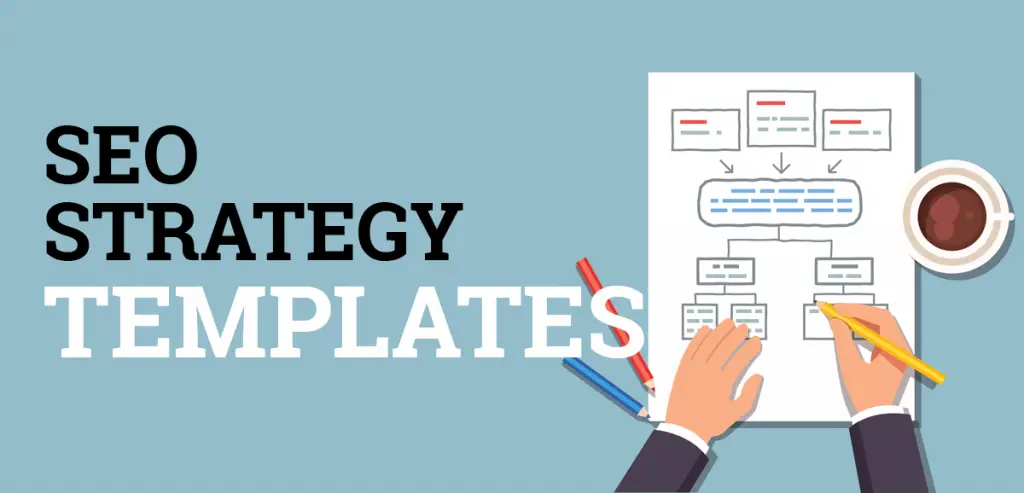In this guide, we’ll answer the question, “what is SEO strategy?” and explain how it’s different than an SEO plan.
We’ll also explain what an SEO marketing strategy is and how it combines the concepts of SEO strategies and plans.
But that’s not all.
You’ll also learn how to build an SEO strategy that works to increase your website’s rankings and traffic in search engines like Google, Yahoo, and Bing. By the end of this page, you’ll know everything there is about developing good SEO strategies that deliver great results for your business.

What Is SEO Strategy?
An SEO strategy is an action plan that improves a website’s search engine rankings to increase organic traffic. A good SEO strategy consists of on-page SEO, off-page SEO, technical SEO, content SEO, local SEO, and mobile SEO practices.
What Is an SEO Plan?
An SEO plan lists the steps required to execute an SEO strategy. SEO plans include a checklist of items and a template to follow to improve the website rankings and organic visibility in search engines.
What Is SEO Marketing Strategy?
An SEO marketing strategy is a detailed list of SEO marketing techniques for achieving a website’s long-term goals with search engine optimization. A good search engine marketing strategy includes a wide range of SEO methods and action items to perform on a website to improve organic search traffic.

How to Build an SEO Strategy
1. Set Your SEO Strategy Goals
The first step in building an SEO strategy is to set your goals.
Once you determine that, then we can move on to specifically answering the question about what are SEO strategies you can use for your site.
Without clear objectives, your SEO plan won’t have measurable data to define your ROI (return on investment).
Start by identifying your target SEO marketing strategy results and then work backward to define the process for your goals.
As yourself questions like:
- Do you want to increase the amount of traffic to a specific webpage or set of pages?
- Do you want to increase the number of sales for a particular product?
- Do you want to improve visibility in the search engines for certain types of content in the buying process (e.g. TOFU, MOFU, or BOFU)?
- Do you want to improve brand recognition and authority in the niche?
2. Make a List of Topics to Cover
The second step to creating an SEO plan that generates higher organic search traffic is to make a list of topics to cover on the website.
But you can’t just choose any topic.
The topics must be laser-focused on the niche that the website is an authority in. And the more narrow you can go in the subject matter, the better it will be for your growth.
A good strategy for SEO is to compile a list of about 3-5 words and terms associated with your product or service. This will give you a good starting point for the topics to cover in your content.
Note: Another good article you may want to read after this one on developing a pillar content strategy. This topic clustering strategy helps you build out supporting content for your main pillar page to help it rank easier.
3. Build a List of SEO Keywords
If you want to develop an SEO strategy that works, then keyword research is your solid foundation. It’s a crucial part of the process that helps you take the topics you came up with in step 2 and write content that matches them to rank high in the search engines.
A common mistake for beginners in SEO is to produce content that doesn’t target specific keyword phrases people are actively searching for on Google as well as repeatedly targeting the same term keywords on various pages throughout the site.
By doing proper keyword research, you can prevent those mistakes from occurring and get a higher ROI for your SEO efforts.
The basic idea for building a list of SEO keywords for your topics is to use a keyword research tool to discover the phrases and terms that directly relate to those topics. Then, you want to cluster similar keywords together on one web page as opposed to writing a separate article for each phrase. (See this related guide for more tips on how to do keyword clustering for SEO.)
You can find related terms for your keyword clusters by using a keyword research tool like KWFinder by Mangools (try it for free). It’s one of the only SEO tools I recommend as an affiliate because it’s cheap, yet powerful for keyword research.
With KWFinder, you can type in a seed keyword and get a list of other related terms people are actively searching for on Google. It also helps you find long-tail keywords (phrases with 4 or more words) to include in your cluster for the page.
The image below shows an example of related keywords I found for this article using KWFinder. And by clustering them together on one page, I can improve the organic search traffic for all of them.

4. Write Content that Meets User Intent
After you have your list of keywords figured out, the next step for how to buildan SEO strategy that works is to write content that meets the user intent for those clusters of phrases.
As mentioned in my guide on how SEO works for websites, search intent is important because the goal of Google’s algorithm is to provide users with the most relevant content for each search query as quickly as possible. And Google serves different types of search results for each query.
If you don’t write and structure your content in a way to matches the intent for a particular query, then your website will never rank for it. The same thing is true for minimum word counts. See this related guide for the best word count for SEO.
But how do you know what Google wants to see on your page for the keywords you’re targeting?
Just perform a search for your target keywords on Google and then analyze the top 10 URLs on the search engine results pages (SERPs).
Every SERP is affected by the search queries entered by the user and those queries fall into three categories: navigational, informational, and transactional. And once you know the type of content Google likes to serve for a particular query, then you can write better SEO content that can rank for those keywords.
5. Optimize Your Meta Titles & H1 Tags
The meta title is one of the most important places to put your keyword phrases in the HTML for your page. The second best spot for keyword optimization is the H1 tag.
In my guide on how to add keywords to a website for SEO purposes, I explain how a meta title acts as a name tag for a web page and is what appears for the listing in the search engine results page for a user to click on.
Therefore, search engines like Google, Yahoo, and Bing put a lot of SEO value on this HTML meta field.
To get the most SEO value out of your meta titles, especially if you’re doing SEO analysis for an existing site, it’s important to follow these two tips:
- Put your highest priority keyword at the beginning.
- Include other important keywords in the text without repeating too many of the same words.
For example, I want this page to rank for these keyword phrases:
- what is SEO strategy
- what is an SEO plan
- SEO action plan template
So I crafted a meta title like this below based on the tips given above:
What Is SEO Strategy? (+ SEO Action Plan Templates to Use)
As for optimizing the H1 tag, you can just copy your meta title tag into that field to get the most SEO value.
By duplicating your meta title into the H1 tag, you’re giving Google a clear signal on what it should display in the SERPs for your web page. There have been reports that Google’s crawler will sometimes grab your H1 tag or another heading tag by mistake and list it in the SERP for your URL.
Following this SEO strategy will improve your overall SEO score and ensure that the algorithm knows which keywords you want the page to rank for and reduce the chance of the wrong text being displayed in the search engine results page for your web page.
6. Optimize Your URLs
Another part of a good SEO plan is to optimize the URLs on the website. URLs with keywords in them tend to rank higher than URLs without them. And the best URLs are ones that give your visitors and the search engines a better clue as to what the content is about.
A simple way to optimize your URLs is to at least include your main target keyword in the page name and put some secondary keywords in if you can.
For example, this web page has this URL:
- /what-is-seo-strategy-plan/
By structuring an SEO-friendly URL like this, Google can detect that the content is answering questions about SEO strategies and plans as mentioned in step 5 above without having to repeat the phrase “what is” more than once in the page name.
7. Optimize Your On-Page SEO
On-page SEO is a strategy you can use to increase rankings and traffic for your website by putting your target keywords in specific areas on each page for the Google web crawler to scan and index.
This simple Internet marketing strategy allows you to maximize the internal ranking power of your content so you can worry less about off-site factors like link building.
On-page SEO elements you can optimize include:
- Page title (usually coded as the H1 heading)
- H2 to H6 subheadings
- Body content
- Images
- Navigation menus
- HTML attributes individual elements on the page
You can learn more about on-page optimization here.
8. Use an Internal SEO Linking Strategy
By focusing on an internal linking strategy that uses optimized anchor text pointing to a target page you can send a direct signal to Google about what the content is about and the keywords it should be ranked highest for.
You can learn more about this concept in my article on internal vs external links; however, the golden rule is this: never repeat your exact match link anchor text more than 50% of the time throughout the website so you can avoid over-optimization.
You want to vary your anchor text so it doesn’t send a red flag to Google and potentially get your website penalized.
For example, if I wanted to rank this blog post for the keyword, “SEO plan”, then I could use the following internal linking plan:
- SEO plan (3 internal links)
- SEO plan here (1 internal link)
- my SEO plan guide (1 internal link)
- plan for SEO (1 internal link)
By using this type of strategy, I’m able to optimize the anchor text for the main target keyword phrase while adding enough keyword variations so the internal links are not over-optimized with the exact match phrase; keeping the page safe from any potential link manipulation ranking penalty.
9. Fix Technical SEO Errors
Every good SEO plan should include a technical SEO audit. Technical SEO is important to understand and implement on your site because there could be some non-content issues that are preventing your pages from ranking as high as they should due to crawling and indexing problems.
A good technical SEO strategy will cover these factors on your website:
- Crawling
- Rendering
- Indexing
- Website Architecture
- Page Speed
- Broken Links
- 301 and 302 Redirects
- 404 Errors
- Structured Data
- Mobile Optimization
- HTTPS
- Duplicate Content
- Hreflang
- Robots.txt File
- XML Sitemap
You can learn more about technical SEO here.
10. Create a Link Building Plan
Link building is an important part of an off-page SEO plan that can improve the popularity, expertise, authority, trust, and relevance of a website.
Good off-page optimization is achieved when you get other reputable sources online linking to or promoting your website, and vouching for the quality of your content.
Google’s How Search Works documentation states the importance of off-site factors like link building:
“Our systems are designed to identify signals that can help determine which pages demonstrate expertise, authoritativeness, and trustworthiness on a given topic. We look for sites that many users seem to value for similar queries. For example, if other prominent websites link to the page (what is known as PageRank), that has proven to be a good sign that the information is well trusted.”
You can get more links to your website by using these common link building techniques:
- Guest posting
- Content marketing
- Link insertions on previously indexed content
- Adding your business to local listing directories
- Checking sites for broken links and offering a replacement to the website owner for your URL
- Blog commenting
- Forum posting
- Participating in question & answer sites
- Posting links on social media
- Social bookmarking
Learn more about off-page SEO here or download our complete off-page SEO checklist and template that’s available in PDF, Excel, and Google Sheet formats.

SEO Strategy Template List (Action Plans)
Here’s a list of the top SEO strategy templates you can use to improve your search engine optimization. Each SEO action plan is free to download and use for your own website.
1. Backlinko SEO Strategy Template
This is a free high-level SEO strategy template that will help you define your target audience, find good keywords, make an SEO plan for content, build backlinks, and more. It’s also available in three formats: Word, PDF, and Google Doc.
2. ClickMinded SEO Strategy Template
If you’re struggling to create an SEO plan for your website, then this template can help you developed a laser-focused strategy to drive traffic more traffic to your pages.
3. Loganix SEO Strategy Template
This SEO marketing agency is giving away free SEO templates for every essential task, including content briefers, content strategy, keyword research, backlink quality checklist, SEO roadmap, website outline, and SEO contract.
4. Bluewire Media SEO Strategy Template
Grab this free 3-step SEO strategy guide to improve your search engine optimization and website visibility in Google.
5. seoClarity SEO Strategy Template
This enterprise SEO business is offering a free SEO roadmap to help you keep all of your SEO-related activities on track, eliminate errors, and streamline the decision-making process.
What are the Top Three SEO Strategies?
1. On-Page SEO
On-page SEO is one of the top SEO strategies you can use to optimize individual pages on your website.
By improving the on-page SEO for your content, you can increase your keyword rankings in Google because the search engine crawler will understand which queries to match your pages with.
2. Technical SEO
Technical SEO is another top SEO strategy you can use to increase your site’s visibility on Google and capture more traffic from the search engines.
Technical SEO relates to the non-content elements of your website that impact user experience and crawlability, including:
- Site speed
- Mobile-friendliness
- Indexing
- Site architecture
- Structured data
- Security
3. Off-Page SEO
Off-page SEO is another top strategy for SEO you can use to improve your keyword rankings and traffic.
This method of search engine optimization is an SEO marketing strategy that helps to strengthen your website’s reputation and authority, which are important factors for the Google algorithm because the search engine wants to display results that are reputable, reliable, and trustworthy for its users.
Off-page optimization includes strategies such as link building, content marketing, guest posting, local listings, and social bookmarking.

SEO Strategy & Plan Summary
I hope you enjoyed this guide answering the question about what is SEO strategy and plan.
As you discovered, an SEO strategy is an action plan that improves a website’s search engine rankings to increase organic traffic. And a good SEO strategy consists of on-page SEO, off-page SEO, technical SEO, content SEO, local SEO, and mobile SEO practices. An SEO plan, on the other hand, lists the steps required to execute an SEO strategy. SEO plans include a checklist of items and a template to follow to improve the website rankings and organic visibility in search engines.
By using those resources and the tips on this page for how to build an SEO strategy for your website, you can create a good SEO plan that delivers measurable results for your business.

SEO Chatter is dedicated to teaching the fundamentals of search engine marketing to help marketers understand how to increase organic website traffic and improve search engine rankings.
